
Text © Dr. Davide Guadagnini

English translation by Mario Beltramini

There are 176 species belonging to the order of the Anseriformes. Here a Dendrocygna guttata, part of the so-called whistling ducks group, due to their vocalizations recalling the warblers © Giuseppe Mazza
Presently, on the base of genetic studies, it is thought that the order can be subdivided in three families. The family counting the greatest number of species, with typical birds, is the vast family of the Anatids (Anatidae) that includes the ducks, the geese and the properly so called swans.
This family is subdivided in 5 subfamilies: the subfamily Dendrocygninae (whistling ducks and similar); the subfamily Anserinae (that includes the so called gees and swans); the subfamily Stictonettinae; the subfamily Plectropterinae and the subfamily Anatinae (that includes the true ducks).
Second family belonging to the order of the anseriforms is that of the Anhimidae to which belong two genera of birds (with three species) really unique from many points of view and that do not seem, even if being such, relative to the other anseriforms.
Finally, there is a third recently created family, that of the Anseranatidae, that includes the Magpie goose (Anseranas semipalmata), unique species.
However, the kinship relations existing among some tribes and species of anseriforms are not yet completely clarified and defined.
Ducks, geese and swans populate all continents but Antarctica and all major islands. Mountain ranges and vast oceans are not barriers to the distribution of the anatids that may skilfully fly over vast geographical areas of different nature. The anseriforms can take advantage from a vast range of ecological niches: from the lagoons to the tropical pluvial forests, from the coastal lakes to the high mountain ones, from the open sea to the remote oceanic islands, from the coasts to the artificial and urban waters, from the great rivers to the small streams, from the meadows and fields to the tundra.
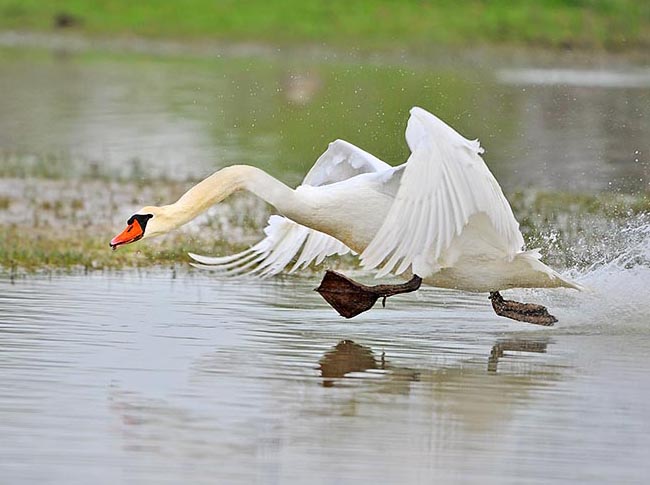
There are species of remarkable size, like this Mute swan (Cygnus olor) obliged to a running start for takeoff, and smaller ones, up to the Cotton teal weighing 120 times less, able even of almost vertical takeoffs from the water © Gianfranco Colombo
The Mallard (Anas platyrhynchos) and the Pintail (Anas acuta), for instance, are distributed in most of the northern hemisphere whilst Madagascar pochard (Aythya innotata), close to extinction, lives in only one lake.
Some species exploit and adapt to a wide range of habitats, whilst others have highly specialized habits like, for instance, Torrent duck (Merganetta armata) living permanently on rushing streams.
Quality and availability of water, substratum of the bottom, type of available food and the presence of emerging vegetation, marshy or floating, are some factors of environmental suitability.
Usually, the anatids have a fairly homogenous structure with large differences in size (the Mute swan, Cygnus olor, is 120 times bigger than the Cotton pygmy goose, Nettapus coromandelianus), proportions of various parts of the body, colours of the liveries, behaviours and habits. Some anatomical resemblances render, in fact, the anatids usually recognizable. The anatomical part allowing to identify most of the anatids is the bill: wide, flattened, with roundish apices and slightly spatulate.
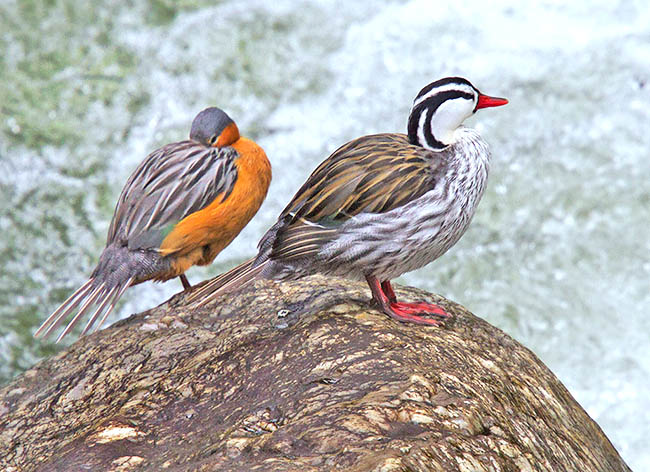
Some ducks even defy the very turbulent waters, like this Merganetta armata pair at home in the Andean streams © Dustin Huntington
To this rules do exist some exceptions, such as, for instance, the seaducks (tribe Mergini) which have long and hooked bills for seizing the fishes.
Most of the anatids have thin and medium-long necks; the swans and some geese have particularly long necks.
Also their bodies do have relatively homogenous shapes; they are ample, stocky and roundish-elongating.
These bodies are usually endowed of webbed feet, rather short.
The most aquatic species, in particular, have shorter feet and brought more posteriorly in respect to the centre of gravity of the body in order to favour the swimming.
The webbing of the feet, between the three toes bent fore, is remarkably reduced in the species that are great walkers and have assumed strong terrestrial habits (especially outside of the period of breeding the ducklings) like the nene (Branta sanvicensis) and the Cape Barren geese (Cereopsis novaehollandiae).
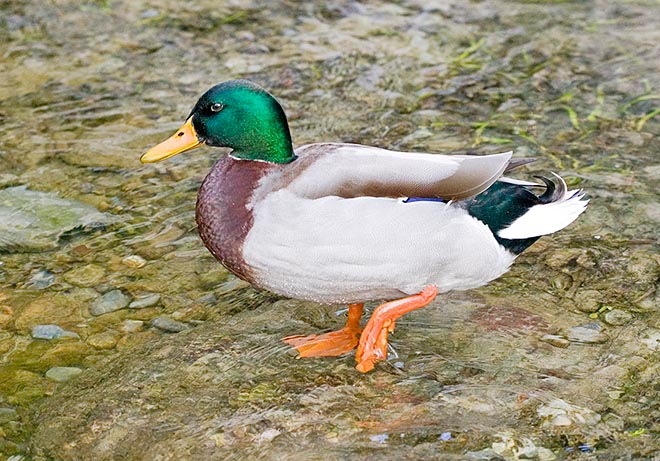
The species diffusion area may be very vast, like for the Anas platyrhynchos, present in most part of the north hemisphere, whilst on the other hand the Aythya innotata lives in only one Madagascar lake © Giuseppe Mazza
In the aquatic species not highly specialized, the centre of gravity is little displaced in respect to the feet which tend to compensate with the length of the toes and with the characteristic latero-wobbly gait.
The species much water-related such as the Black-necked swan (Cygnus melanocoryphus) and some marine species with the rigid tail (tribe Mergini) have such a difficult terrestrial gait that they rarely get out from the water building their nests in the water itself or quite close to it.
Although usually being skilled fliers that can perform incredible seasonal migrations, there are also anatids who have completely lost the ability to fly. This is the case of the South-American steamer ducks (genus Tachyeres). Some anatids have adapted to drink brackish and salty water thanks to the development of specific salt glands. In some species, the bills are adorned with fleshy excrescences; these ones and the colouration of the bills (in some species) become bigger and more coloured during the reproductive season.
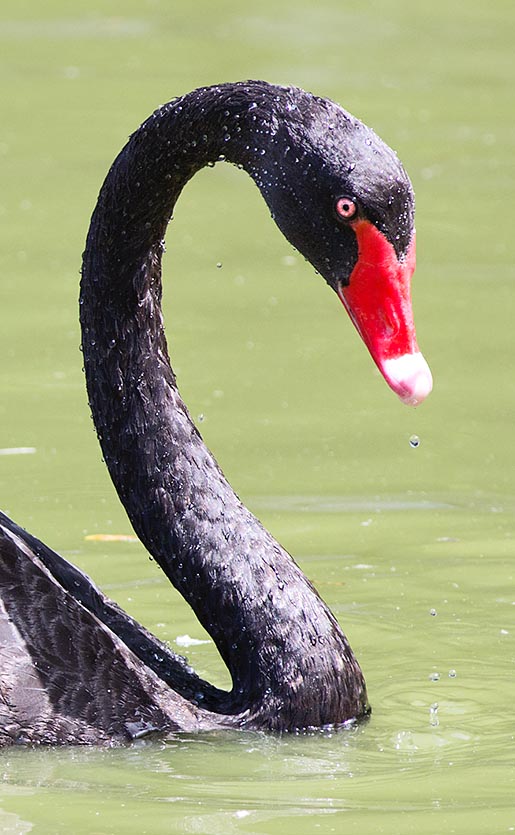
The neck is often long, here a Cygnus atratus, for exploring the submerged vegetation © Giuseppe Mazza
The species living in the rigid climates have a particularly developed circulatory system in the feet in order to avoid the freezing of the feet.
The anatids have a very abundant plumage, fundamental for the thermoregulation and for a good isolation in the aquatic habitats where they live.
The plumage is controlled and moved by many subcutaneous muscles.
The anatids have 10-11 primary feathers (the first is the shortest and the ninth is usually the longest) and 12-24 secondary feathers.
Some species have carpal spurs, used in the fights. The tails are generally short but with some exceptions.
The liveries of the anatids can have brilliant and lively colours crossing the entire spectrum of the rainbow standing among the most beautiful present in the animal kingdom.
The anatids have the highest number of species presenting a marked sexual dimorphism; about half of the total species has this characteristic.
Excepting the sizes in the swans and the geese (especially the northern ones), the sexes are much similar and the plumage is usually less coloured and iridescent in respect to the ducks.
Some masculine ducks exhibit wonderfully coloured liveries with unbelievable combinations of colours. In some species of anatids are present modified quills and feathers: elongated, forming crests, curled, sickle-shaped, velvety, etc…
The particularly brilliant colourations are seemingly associated to the species establishing seasonal pair bonds; these colourations, combined with elaborate courtships, are important to avoid the hybridizing among different species.
This is why insular species have similar and not multi-coloured sexes; having no contact with other similar species, the lack of competition renders unnecessary such liveries. The females of ducks, in particular of species living in the northern hemisphere, contrary to their males, have dull and camouflaged liveries.
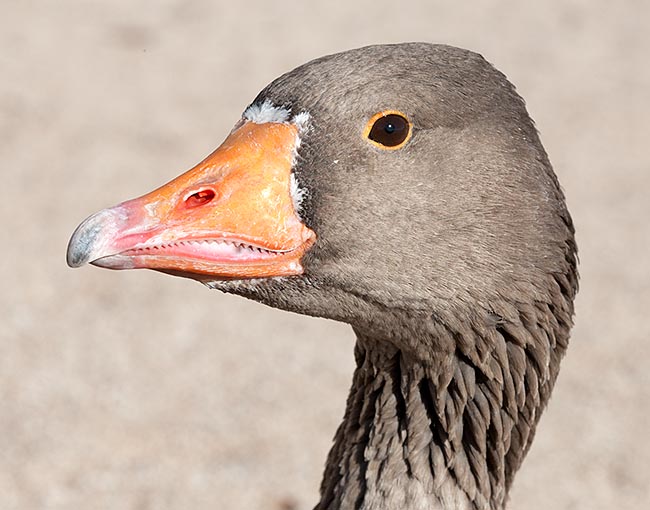
The bill, usually spatulate in the ducks and conical in geese and swans, is at times indented for crushing the vegetables. To note also the fleshy tongues covered by horny projections similar to spines for filtering water © Giuseppe Mazza
The specula allow the specimens of the same species to easily be recognized thus fulfilling the important role of social and sexual “signallers”; the same functions have the dark portions in the clear wings (the Coscoroba swan, Coscoroba coscoroba; and the Snow goose, Chen caerulescens) or the clear portions in the dark wings (Black swan, Cygnus atratus).
The plumage is subjected to a complete change (moult) once a year (geese, swans) or twice a year (ducks; the remiges are anyway replaced only once).
The complete moult usually takes place during the reproductive season, when there is abundance of energetic food; in this period, the anatids, lose the capacity to fly due to the simultaneous loss of the remiges for about 3 (small ducks) up to 5-6 (big geese, swans) weeks.
In some species, males and females have moults happening in different periods. The species endowed of strong sexual dimorphism, with brilliantly coloured males, in the post-nuptial period (by late summer-end of same) and in correspondence to the second moult they assume a mimetic plumage that renders them similar to the females.
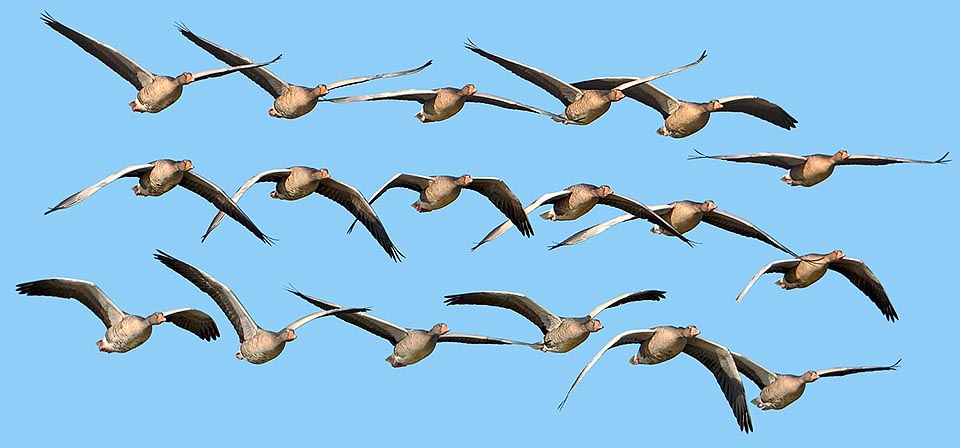
They are often gregarious animals and great flyers, like the Anser anser. Anier indicus, very close relative, makes incredible migrations flying at 9000 m of altitude © Gianfranco Colombo
This eclipse livery favours the camouflaging of the males preserving them more from the predators in a period when they must not compete for the females nor show up to the same. The anseriforms bathe often (also the less strictly aquatic forms) for cleaning and maintaining in order the plumage that is frequently groomed using the bill and the feet.
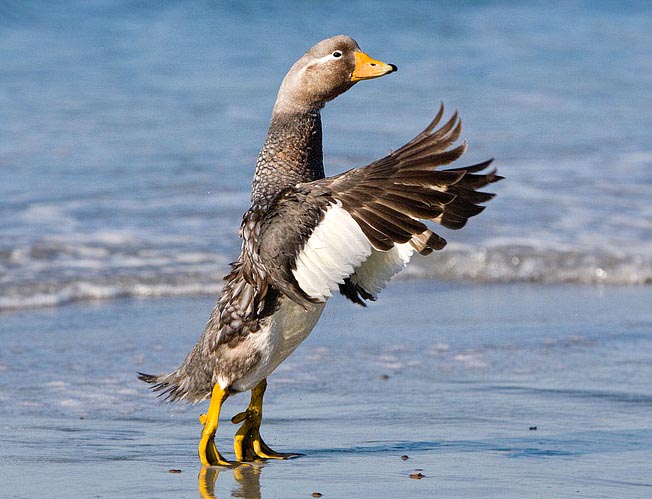
Conversely, South America Tachyeres brachypterus has totally lost the flight habit © Dickie Duckett
They have a developed uropygium gland for the production of an oily and waterproof secretion which is transferred and spread with the bill on the plumage.
Usually the anseriforms can emit strong and loud vocalizations having functions of defence, of courtship, of intra-specific recognizing and for maintaining the contact inside the moving flock (migration).
In many species the two sexes emit different sounds.
Some whistles, hums and sounds are created also by the passage of air through the fringing of the feathers of the wings during the flight.
Many species of anseriformes, especially out from the reproductive season, are gregarious especially for the search for food, the rest and the migrations: moreover, several species have colonial reproductive habits. The fact of living in large groups has many advantages concerning the finding of food, the watch done by sentries during the assumption of the food, the rest, the hatching…., the following the proper route of migration (mainly by the young), etc..
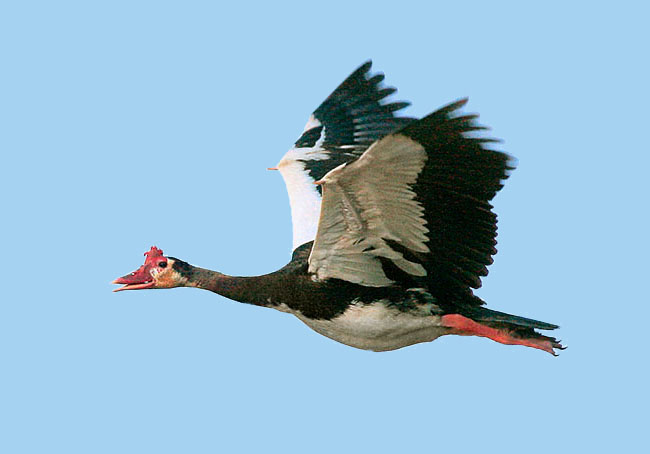
Another original species of this group is Plectropterus gambensis, big goose with duck head and showy wing spurs © José Bazán Hiraldo
The shape ample and flat of the chest is rightly due to the anatomical conformation suitable for the flight; the anatids, in fact, have ample and developed pectorals inserted on the well keeled sternum.
The strength of the flying muscles compensate the sizes of the wings which are not often particularly big (in respect to other species of birds), if compared to the dimensions of the body.
The takeoffs and the landings of the anatids are often challenging and for many species they must take place only in water.
The species doing the longest and most impressive migrations do this for reproducing, in a concentrate period, in the extreme north where the food resources are many also thanks to the many hours of light. In these northern regions, the young can grow up very quickly to then go back southwards before the frost comes back. Another characteristic belonging to all the birds belonging to this order is the one that all the precocious newborns are capable to float and swim since the very first days of life.
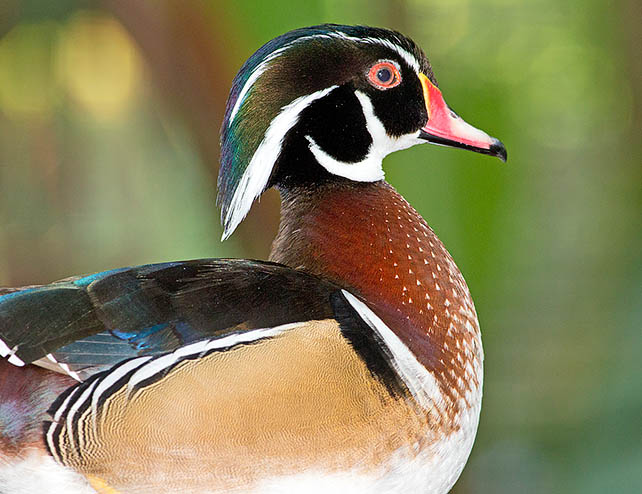
Being often seasonal pair bonds, to avoid misunderstandings and hybridizations, the anatids have the largest number of species with clear sexual dimorphism, like this Aix sponsa male of North America © Giuseppe Mazza
Some species can plunge even for some tens of metres of depth but never reaching the capacities of other genera of more specialized birds such as the penguins or the alcids.
Some so-called “diving” ducks may remain under water for some minutes.
Most of the anatids have wide and flat bills equipped with many transversal lamellae and have fleshy tongues covered by horny projections similar to spines.
These structures serve for filtering and sieving the food; the water is sucked through the apical part of the mouth and pushed out laterally retaining the food by means of the lamellae.
The only other order of birds nourishing in such way is that of the flamingos. In the geese the bills and the lamellae are modified to allow the birds to graze and tear the grass they eat. The bill of the mergansers, on the contrary, are indented and equipped with a terminal hook for seizing and holding the fishes they nourish of. The most the alimentation is specialized, the most the bill will be conformed in suitable way for the use.
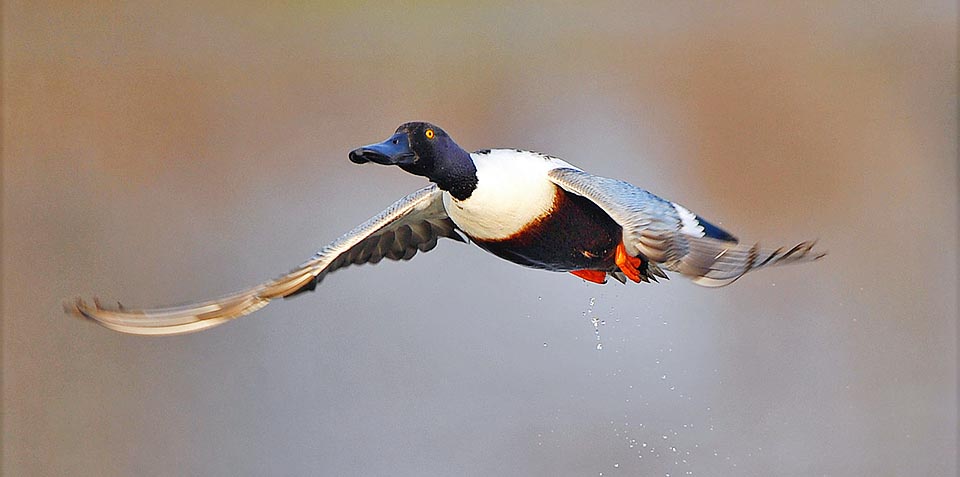
Also in Europe the male of the Shoveler (Anas clypeata) does its figure with a much showier livery than the female and if for many anatids the love is a seasonal matter, there are also monogamous pairs lasting all life. The courtship rituals can be much elaborate and complex also considering the internal copulation © Gianfranco Colombo

Unusual and colourful feathers but also showy fleshy excrescences on the bill like this Tadorna tadorna. Coupling takes place mainly in water, with the females in a flattened posture to invite the partner © Gianfranco Colombo
Many species of anatids are mono- gamous with variable duration of the pair bonds depending on the species; in some the pair may remain as such even for years (or for ever) and out from the reproductive period; in others the pair forms seasonally.
Other forms do not form pairs or are polygamous.
The courting rituals may be much elaborate and complex.
Usually what induces more the starting of the courtships is the lengthening of the day hours which stimulate the enlargement of the testicles and the functioning of the gonads.
The receptive females assume flattened positions in water that invite to the copulation.
Excepting few species (magpie geese, nene, and some cereopsid geese), all the anseriforms mate usually in water.
Contrary to many other birds where the mating happens through simple cloacal contact, the so-called “cloacal kiss”. In the anseriforms, being the males equipped with a pseudopenis shaped like a corkscrew, there are couplings with penetration.
During the copula the male gets on the female holding her with its own bill through the quills of the nape; the female can be almost totally immersed keeping out from the water only the head; the coupling is usually rather quick. During the nesting, geese and swans are usually very aggressive and territorial. The nests of the anseriforms can be realized in many different locations: on the water, on the banks and in the swampy zones, far away from the water, in cavities of a tree and of other type, on trees even using nests of other birds, on rocky protuberances, in the human dwellings and in the artificial nests; one species (the black-headed duck, Heteronetta atricapilla) is obligate parasite.
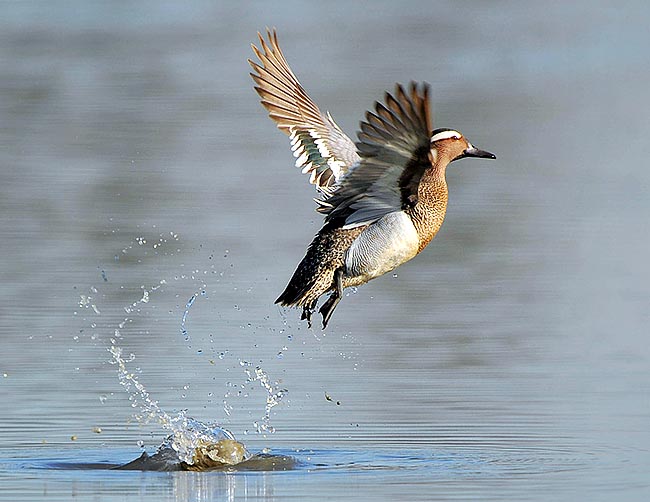
Takeoffs and landings are often demanding and for many species occur only in water © Gianfranco Colombo
Some species adopt very particular reproductive strategies nesting close to predatory birds, always nesting, which indirectly defend the clutches of the anatids.
Nesting in cavities anatids often emit hisses similar to those of the serpents in order to discourage possible predators.
Also the big colonial reproductions concentrated in a unique, short period, have the purpose of contrasting as much as possible the predators action.
The anseriforms lay eggs generally decent sized eggs with rather clear colours: white, yellowish, greenish, bluish, greyish, and brownish.
The eggs are usually covered by down that camouflages them, besides protecting them from the cold, when the mother gets out from the nest. The brooding begins usually once the deposition is completed; the eggs are laid every 1-2 days, in way that the chicks are born synchronised. Excepting the Magpie geese (Anseranas semipalmata), some Black swans (Cygnus atratus), the whistling ducks (genus Dendrocygna), and the white-backed ducks (Thalassornis leuconotus) only the females hatch.
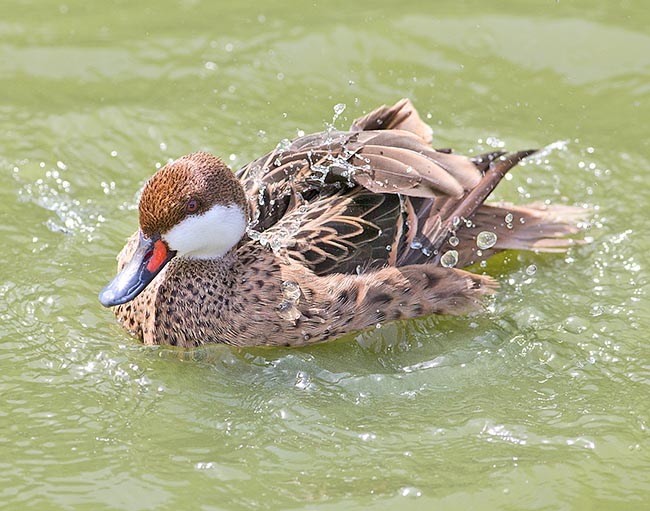
A happy Anas bahamensis while cleaning the plumage among the sprays © Giuseppe Mazza
The vocal communication between unborn and the mother may begin even 2-3 days before the eggs hatching thus favouring the imprinting.
The hatching, starting from the first pecking (chip), lasts 16-18 up to 24 and more hours.
The chicks are precocious and already able to nourish actively, usually they leave the nest after one day when well dry and after having recovered from the fatigue of the hatching.
In most part of the ducks, it is the mother, alone, who cares the progeny. Conversely, in some species of ducks, in the geese, in the swans and in the screamers, both parents care and defend the chicks.
The mothers keep the newborn warm during the first days of life.
The parents maintain with the progeny a continuous vocal contact that calms them while they are busy in nourishing and in swimming; in case of danger, the adults emit cries of alarm that cause the young to flee and hide. The newborns are able to swim and to dive a few hours after their birth; the parents accompany them where the food is abounding and, in water, may render it more available by moving the bottom with their legs.
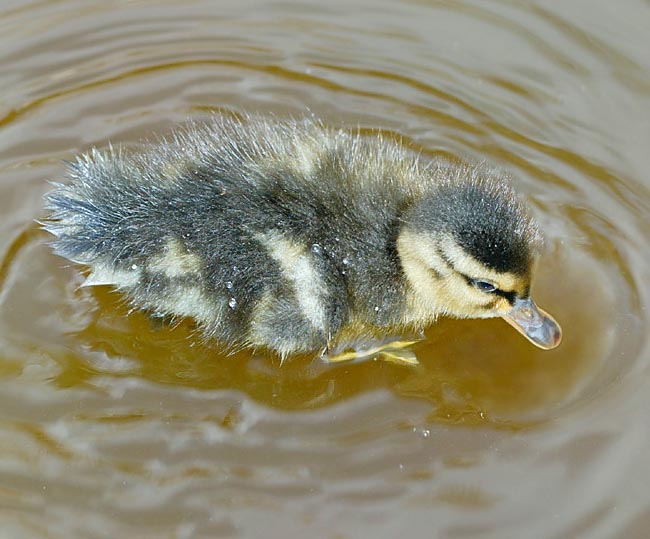
Chicks, here a jaunty Anas platyrhynchos, swim since the first hours of life © Giuseppe Mazza
The growth of the young is quite rapid especially in the northern species that must be able to fly when few weeks old.
The great part of the ducks reaches the maturity when 1 year old, some species (shelducks, genus Tadorna, eiders, genus Somateria) when 2-3 years old; usually the gees begin to reproduce when 3 years old and the swans by the fourth year.
These birds may be fairly long-lived; some species (especially when in captivity) may live 20-30 years with some case of swans that lived up to 50 years.
In nature the things go on differently: the anseriforms, in fact, have many natural foes and are much predated.
Also adverse climatic conditions, food shortages and negative environmental impacts caused by the man have led and continue to lead to the decline many species.
In the past century, 4 species were extinguished by humans. The worst impact, for the birds belonging to this splendid order, is given by the massive destruction, drainage and degradation of the humid habitats.
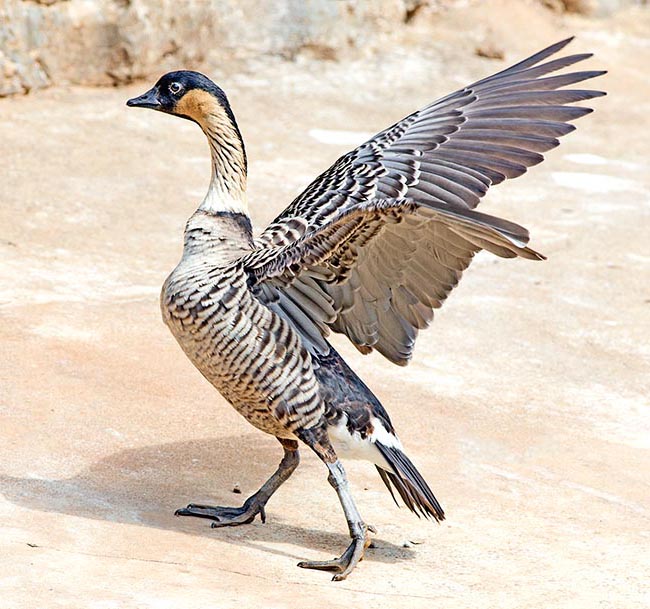
But not all the anatids are strictly linked to the water. Branta sandvicensis, for instance, loves walking and has reduced the palms replacing them with insulating pads to walk on the lava rocks. Has risked extinction © Mazza
The dendrocygnas are commonly called tree ducks or whistling ducks. Whilst the first name is somewhat improper, seen that some species do not use the trees as perches, the second one is more appropriate; all dendrocygnas emit strong vocalizations, repeated, whistling and that recall chirps of songbirds.
They are peculiar ducks; they have some anatomical particularities and some behavioural aspects more common with swans and geese than with the properly called ducks. To the subfamily of the Plectropterinae belongs a unique African species counting two subspecies: the Spur-winged goose (Plectropterus gambensis); it is a large goose with the head of a duck and furnished of large alar spurs.
Also the subfamily of Stictonettinae, counts only one genus and only one species.
It is the Freckled duck (Stictonetta naevosa), a small Australian duck with a peculiar “off-white” plumage. To the subfamily Anserinae belong many tribes that include the delicious pygmy geese (tribe Nettapodini), the strange and aggressive Australian Musk duck (tribe Biziurini, species Biziura lobata), the ducks called with the generic term of stiff-tailed (tribe Oxyurini), many geese of various genera (including the geese performing the most important migrations: genera Branta, Chen, Anser), the swans, the Pink-eared duck (Malacorhynchus membranaceus) (Anserini).
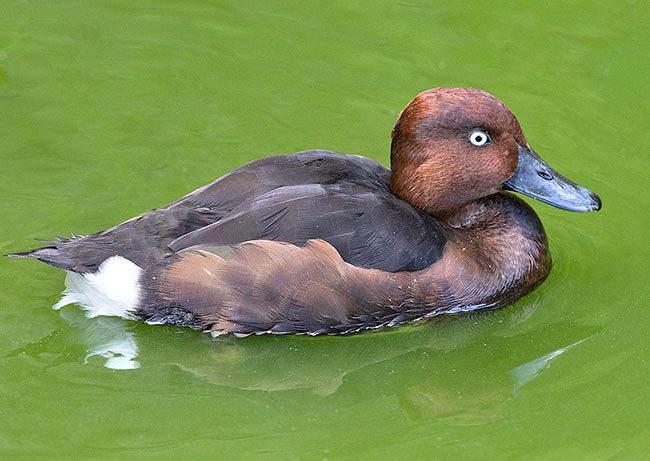
Many species, like the tiny and cosy Aythya nyroca are now unluckily endangered not only by natural predators, but also by the habitat loss, hunting, recent climatic changes and, finally, the human activities © Giuseppe Mazza
To the subfamily of the Anatinae belong the already quoted Torrent duck (Merganetta armata), all the other geese belonging to different genera, the tadornas (tribe Tadornini); the eiders, the long-tailed ducks, the scoters, the goldeneyes, the mergansers, the Smew (Mergellus albellus) (tribe Mergini); and all the species of remaining ducks (tribe Cairinini, tribe Callonettini, tribe Aythyini, tribe Anatini).
Belong to this subfamily also the ducks that have originated the numerous forms and domesticated races of ducks bred by the man. These are the well known Mallard (Anas platyrhynchos ) and the Muscovy or Mute duck (Cairina moscata).
To the family of the Anhimidae belong three species of birds unique due to the anatomic-physiological peculiarities as well as to the behavioural ones. Even if this family belongs to the order of the Anseriformes at a first approximate observation, the three species of screamers do not seem to have anything in common with them (the close relationship is, on the contrary, evidenced by a series of anatomical affinities).
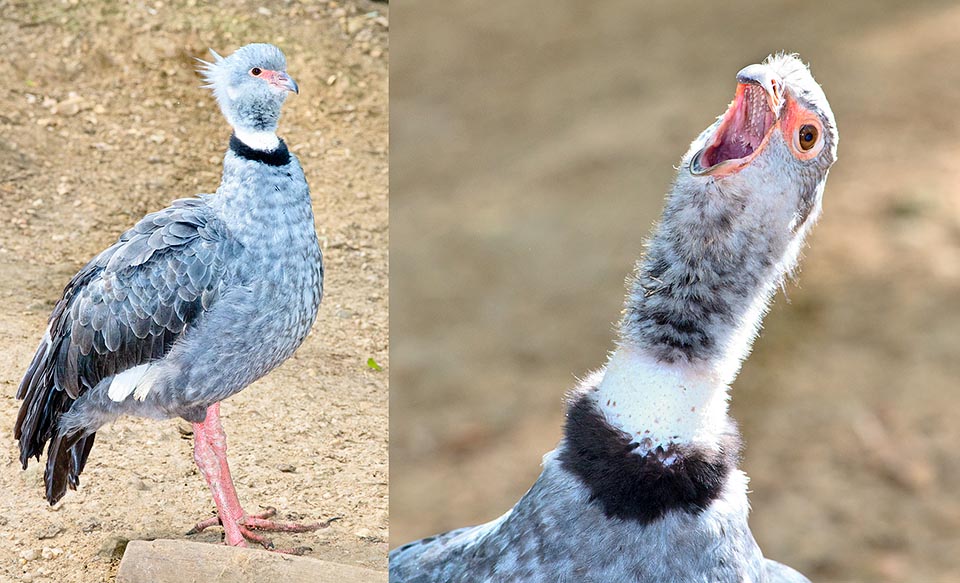
Chauna torquata has little common with the other Anseriformes: not webbed feet with long toes, chicken head with raptor beak and anatomical particulars in common with the famous Archaeopteryx, an early bird lived 140 million of years ago. The are called “screamers” due to the cries heard kilometres far away © Giuseppe Mazza
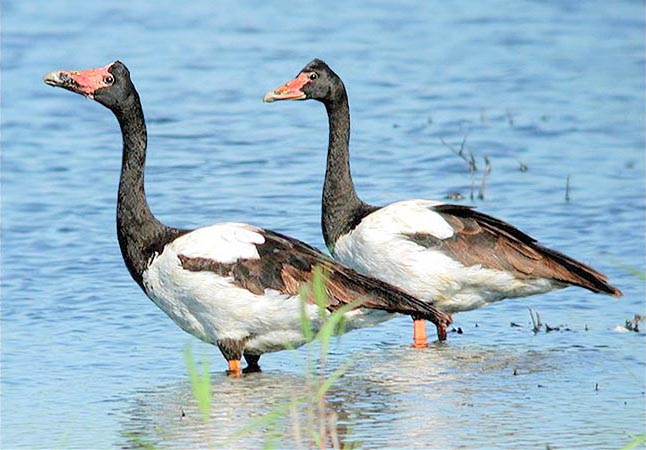
After the DNA, Chauna torquata is genetically close to the equally strange Anseranas semipalmata, here shown. These two species, with the Biziura lobata, are the only anseriforms that nourish their chicks directly with the bill © Ian Montgomery
Among the almost 9700 species of extant birds, only the screamers, the penguins (order Spheniscidae), the rates and the African mousebirds (order Coliiformes) have a plumage uniform all over the body.
In all other species, despite the feathers appearing to be everywhere, they actually grow only along determinate lines and in specific zones.
The plumage of these birds appears more flexible, more unkempt and less typically adherent than the plumage of the aquatic birds belonging to the same genus (anatids).
The screamers are the only extant birds having no hooked processes of the ribs (anatomical structure typical to the flying birds that allows the ribs to hook one another giving robustness to the ribcage submitted to the tensions caused by the flight). The only other bird without this anatomical structure was the famous Archaeopteryx , an early bird of 140 million of years ago. The screamers, though being perfectly comfortable on the ground and in the humid zones, where they spend most of their time and where they reproduce, are also excellent fliers, equipped with large wings thanks to which they may spend much time soaring in the sky and that allow a powerful flight.
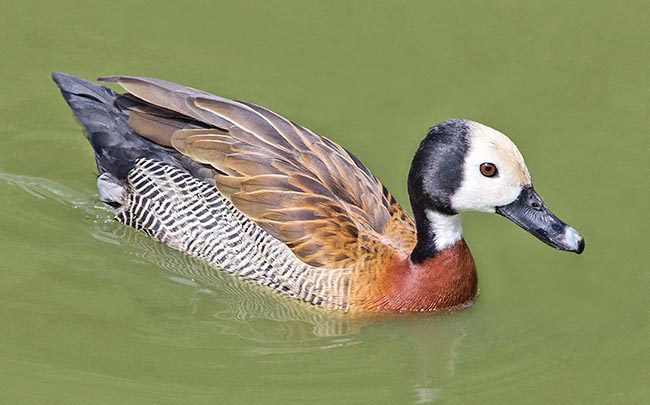
Cosy Dendrocygna viduata. In this genus, the neck and the legs are long, the posture vertical, with elegant gait and well far from the soil. Contrary to the screamers it communicates with a tuneful whistling © Giuseppe Mazza
They ascend spirally taking advantage from the thermal currents even to very high altitudes.
During the flight the neck and the feet are carried elongated (the feet, due to the long toes, slightly dangling). The screamers are rightly indicated with this term because of the distinctive character of their sounds that can be heard even far away (some km) thanks to the unbelievable volume of their extraordinarily powerful voice.
Sounds that, once heard, are difficult to forget. The males emit more whistled sounds and of slightly minor intensity than the females.
The perched flocks may vocalize continuously even for hours and usually when a specimen begins to sing it stimulates the others to join in the chorus.
These birds live in ample open spaces frequently flooded to form marshes and swamps, in savannas, prairies and lakes with abundant aquatic vegetation.
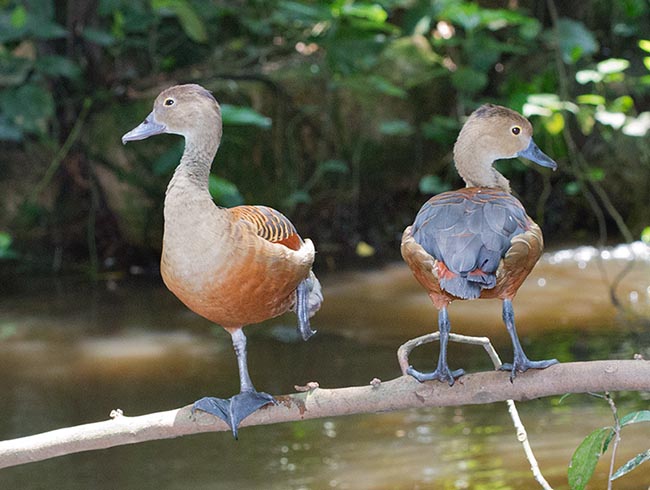
The dendrocygnas, called also whistling or tree ducks, often love, like the Dendrocygna javanica, to rest on trees branches along streams for disappearing from predators and calmly observe the environment © Giuseppe Mazza
The nesting pairs, usually, are more linked to the aquatic and humid habitats which grant more protection to the chicks.
The screamers are highly territorial during the reproductive season and are gregarious during the other periods of the year reaching to form flocks of tens, hundreds or thousands of individuals.
Despite the size and the terrestrial habits, these birds can perch without any problem on the trees also thanks to their long toes.
They perch on the free top of the trees thus being seen even from far away; from these locations, which are rapidly reached when they feel menaced, the screamers observe the surrounding territory in order to evaluate the possible danger.
The seasonal movements of these species are little known; thanks to their flying skill, they are able to perform however even long displacements. They are mainly linked to the availability of food and to the research of the same. The northernmost populations, less gregarious, are more sedentary. The reproductions, even if they may occur during the whole year, are usually concentrated during the austral summer with the first spawning usually done in September-October.
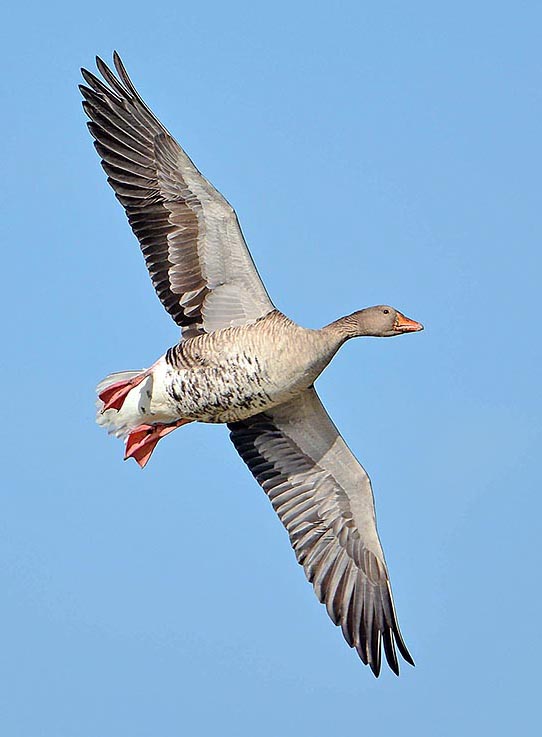
A splendid flying Wild goose (Anser anser ). The anseriforms are very interesting birds, wonderful to observe in nature, still now important for human alimentation © Colombo
When laid, they are of dark white colour in the species belonging to the genus Chauna, turning yellowish during the incubation, and are pale green/brown-olive in the species belonging to the genus Anhima.
The hatches are formed by 2-7 eggs (in the tropical zones they usually lay more eggs).
These are covered by vegetation (to hide them from the predators) when the parents get away from the nest; these birds, contrary to the other anseriforms, do not tear off the down for lining the nest.
Both sexes care the hatching which lasts about 40-47 days with an average of 42-45 days. Both parents take care of the breeding of the chicks that look like little geese but with beaks like chicks of chicken and not webbed feet.
The young have a yellow-greyish colouration with the ventral parts more pale yellow-whitish. The screamers, if treated in the right way, may become confident birds and quite easy to approach.
This tendency renders the screamers easy to domesticate and some natives breed them in the chicken coops because they are excellent guard animals as the strongly scream in case of danger (characteristic they share with many geese and swans); some people say that they defend their courtyard companions from the attack of some predators.
The screamers are bred, not abundantly, in zoos and in few private collections (mainly the southern screamers).
It’s a real shame that such interesting birds and rather easy to breed are not more diffused in the aviaries. In a zoological park their strong sounds would blend well with those of other famous animals of the jungle. The screamers are special creatures due to the contrasting anatomical, but also behavioural, peculiarities that coexist in the same species; only to summarize some: they are birds equipped with hooked beaks and long wing spurs in a body physiologically similar to that of a goose but that, in the general overall, recalls that of a big galliform.
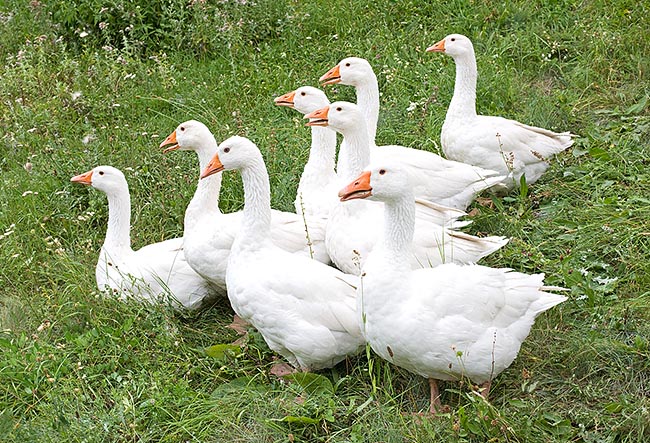
Apart ducks, the geese bred with many races in the world, come all from the Anser anser and the Anser cygnoides © Giuseppe Mazza
Finally, to the family Anseranatidae, belongs the Magpie goose (Anseranas semipalmata), so called because of the contrasting colour white-black of the livery.
This bird that resembles a goose with scarcely webbed feet has a head that, with a little imagination, recalls that of a small “dragon of the fairy tales”.
Also its biology is very interesting and peculiar; for instance, to the rule of the temporary loss of the flying capacity (simultaneous loss of the remiges) is rightly an exception the magpie goose which is subject to a gradual moult without consequently losing such capacity.
The anseriforms are very interesting birds, wonderful to observe in nature and very much appreciated by the breeders of ornamental birds. Some species, domesticated in historical times, have been and are still very important for the human sustenance.
→ To appreciate the biodiversity within ANSERIFORMES please click here.
